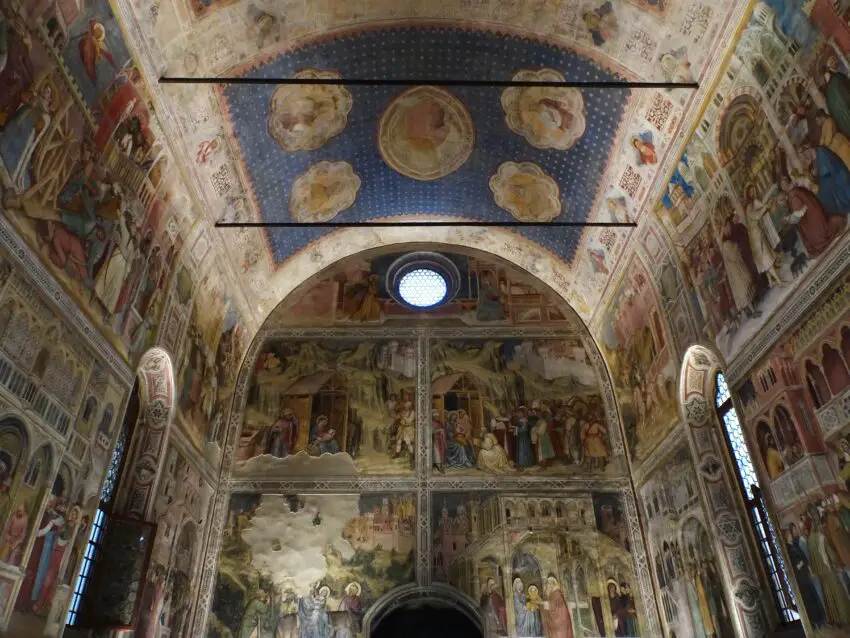Pretty Padua in Northern Italy’s Veneto Region seems to dwell in the shadow of its more famous neighbours Venice and Verona and therefore only sees a fraction of their visitor numbers. For that reason alone, we wanted to drop by and explore the beautiful historical city centre and stroll around the World’s oldest Botanical Garden.
However, the city’s most famous attraction is a series of beautifully preserved medieval Frescoes by such eminent figures like Giotto di Bondone. The artworks are so unique and influential to the development of European art that the UNESCO decided to inscribe eight of them onto their list of World Heritage Sights in 2021.
During our stay in Padua, Stefanie and I managed to check out all of them, so we can tell you exactly which of these you definitely shouldn’t miss.
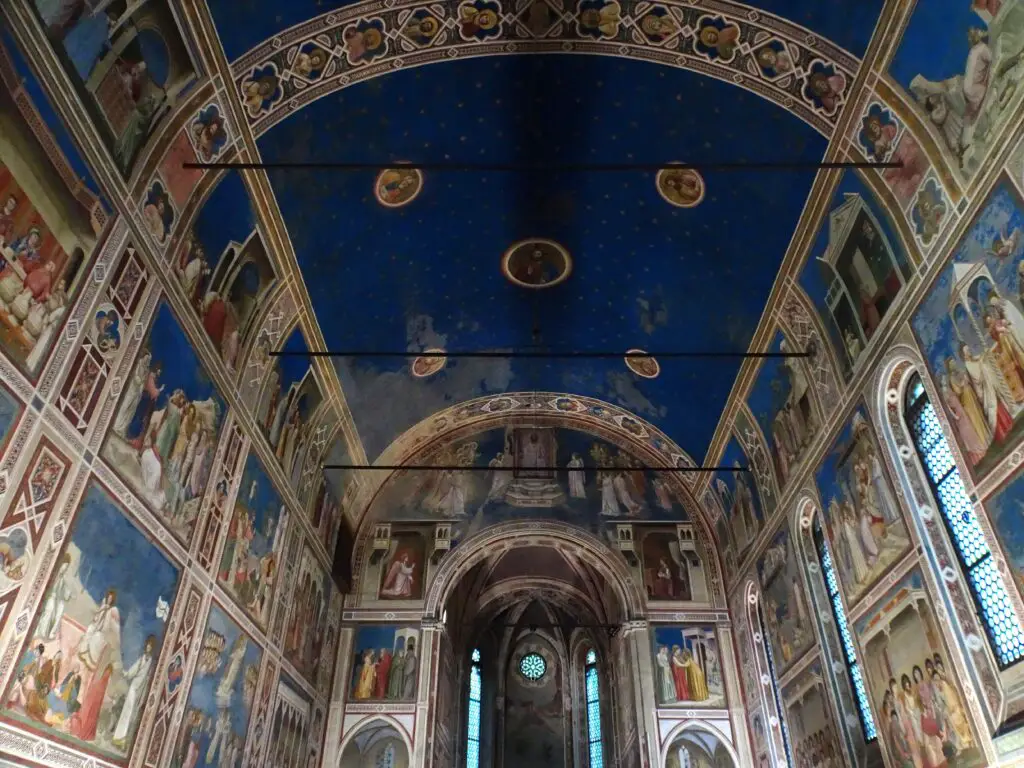
This post may contain affiliate links, and I might earn a small commission at no additional cost to you. For more info, click here.
Where are Padua’s frescoes located?
The eight fresco cycles inscribed as World Heritage Sites are organized in four main zones, grouping together sites that are close to each other. It’s a sensible designation and one I’ve stuck to below to outline which of the sites can be combined. Still, as one would expect some of the frescoes are more impressive than others and I’ll give you my top picks afterwards.
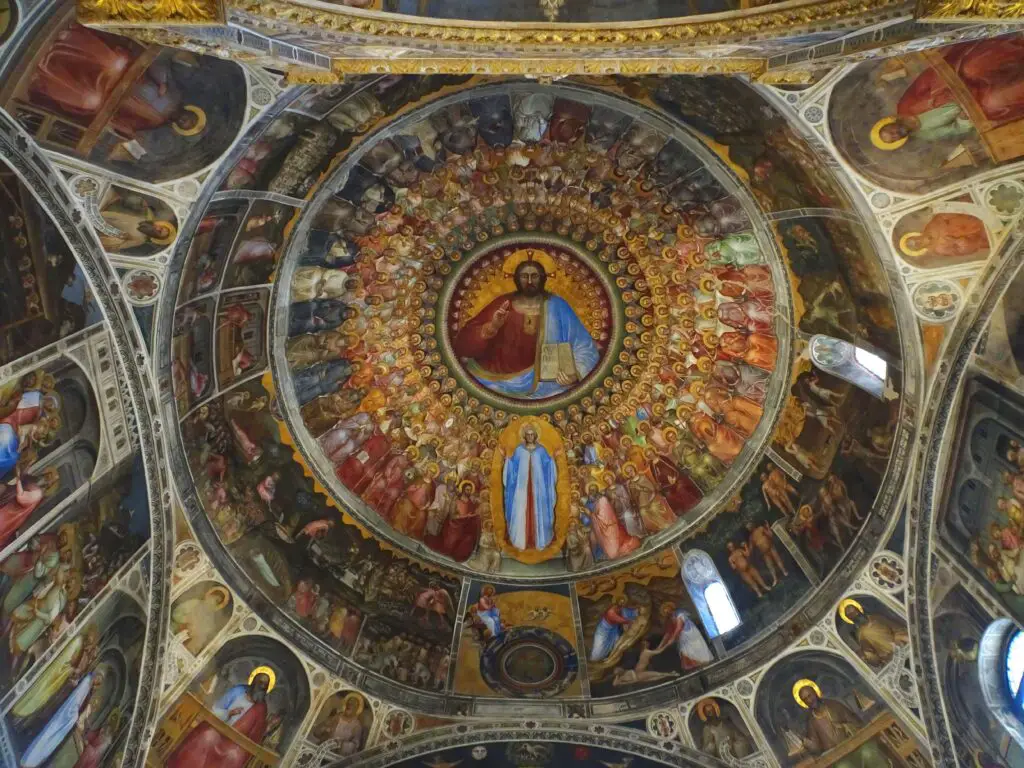
Zone 1 includes the Scrovegni Chapel and the Church of the Eremitani at the northern end of the city centre. Zone 2 groups together the centrally located Palace Cathedral Baptistery, Palazzo de la Ragione and Chapel of the Cararesi.
Zone 3 consists of the Basilica and Monastery of St. Anthony and the Oratory of St. George south of the centre near the Botanical Garden, while Zone 4 only contains the Oratory of St. Michael at the south-western end of the city centre.
Have a look at the map below to see where the sites are located.
Exploring Padua’s 14th century fresco cycles
Zone 1
Giotto’s Frescoes in the Scrovegni Chapel
The Scrovegni Chapel is the most famous of all the listed sites and it’s easy to see why. The small chapel is completely unassuming from the outside, but the interior has been covered in countless biblical scenes, whose level of detail left us pretty much awestruck.
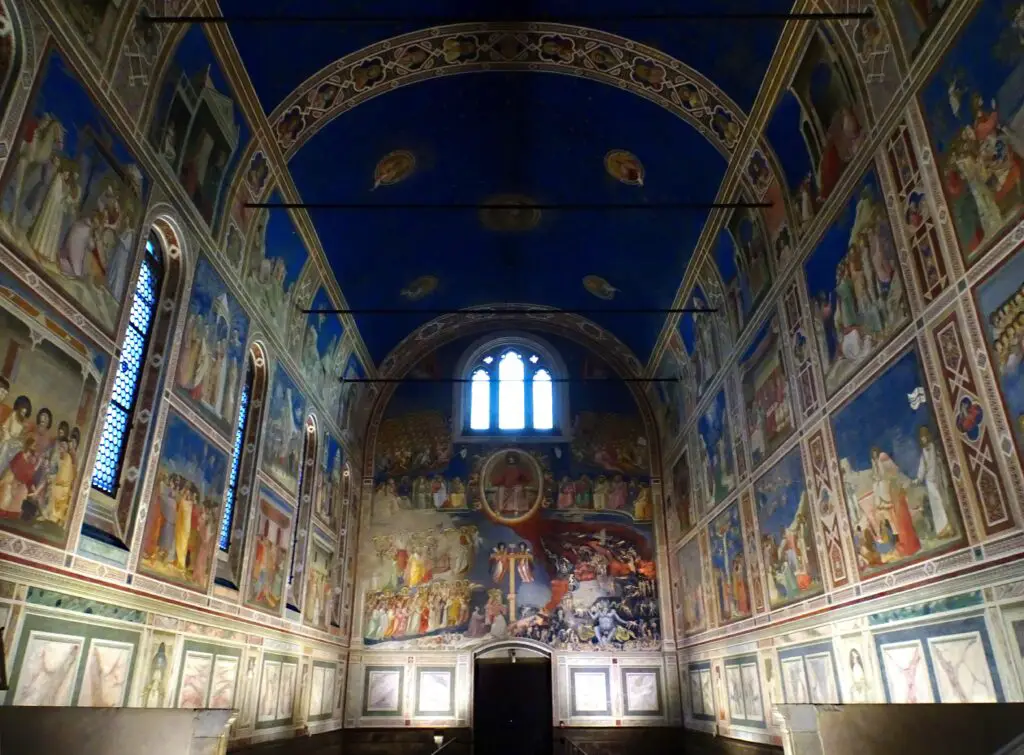
The frescoes are works of the famous Gothic artist Giotto, who had been commissioned by Paduan banker, Enrico Scrovegni to paint them in the first decade of the 14th century. The front wall is decorated with a scene from the last judgment with vivid depiction of hell that reminded me of the works of Hieronymus Bosch.
The lateral walls are covered in a series of scenes (think comic panels) retelling the Life of Christ and the Life of the Virgin Mary. The dynamic realism of the figures is quite ahead of its time and already points to the developments of Renaissance Art to come.
Some of the scenes were considered shocking at the time, especially the one of Joachim meeting Anna at the Golden Gate as it shows the pair kissing. I can just imagine the ranks of stuck-up nobility fainting from just looking at it. The scene can be found in the top right corner of the left wall when looking at the Last Judgment.

The chapel is on the grounds of the Museo Civico and can only be visited with a timed ticket. Before entering you’ll have to decontaminate by sitting in a small room watching a video of the chapel’s history. Afterwards you have about 15 minutes to check out the artwork.
Church of the Eremitani
The church of the Eremitani is in the direct vicinity of the Scrovegni Chapel but can be visited free of charge. Inside you’ll find three listed fresco cycles. The left wall of the main chapel contains a fresco cycle by Guariento depicting the life of Saints Philip, Augustine and James.
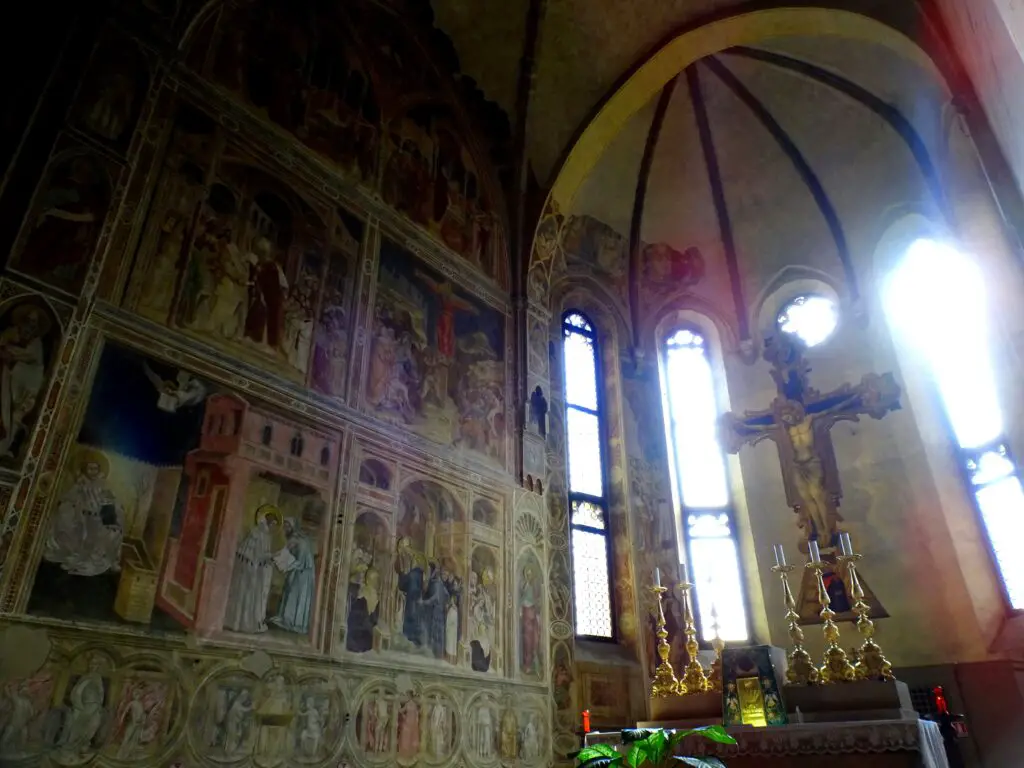
The same artist painted the Cappella di Sant’Antonio, which is the second side chapel on the right coming from the entrance. The Cappella Cortellieri, directly to the right of that one has a few remaining paintings by Giusto de’ Menabuoi.
Zone 2
Cathedral Baptistery
Amongst all of sites listed here, the Cathedral Baptistery was my personal favourite. The small baptistery belonging to Padua’s main Cathedral is a nice contrast to the kind of bland interior as well as the somewhat unattractive exterior of the main church building. It’s easy to lose yourself in the Baptistery’s beautiful scenes painted by Giusto de Menabuoi and covering the entire walls and the central dome.
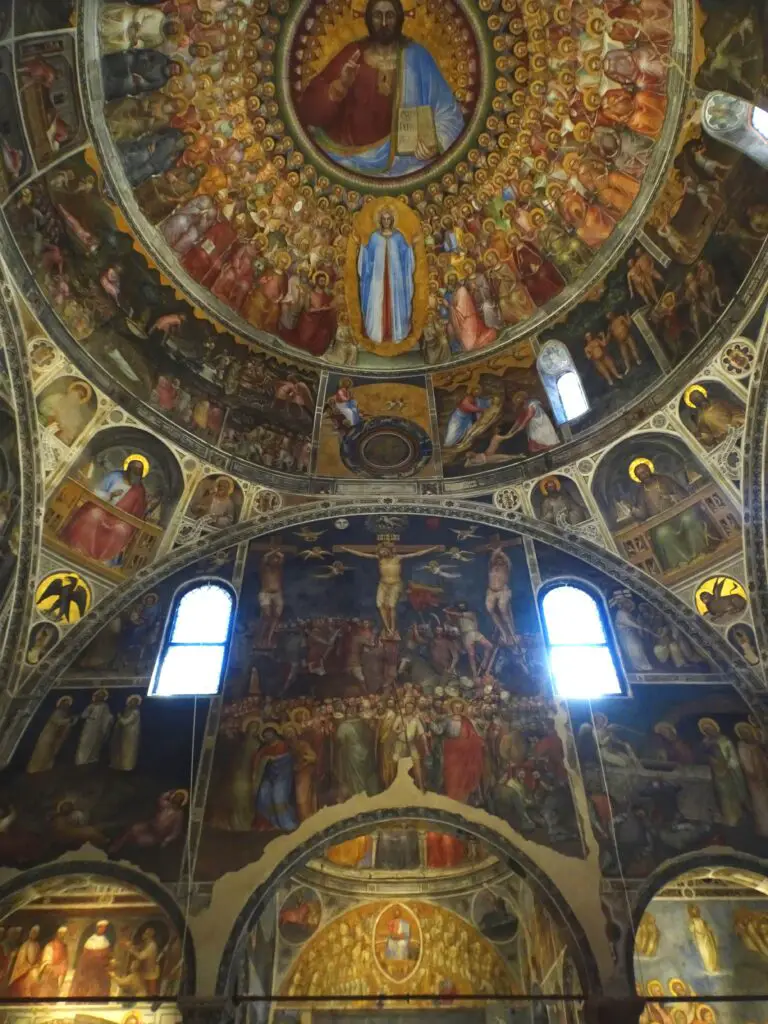
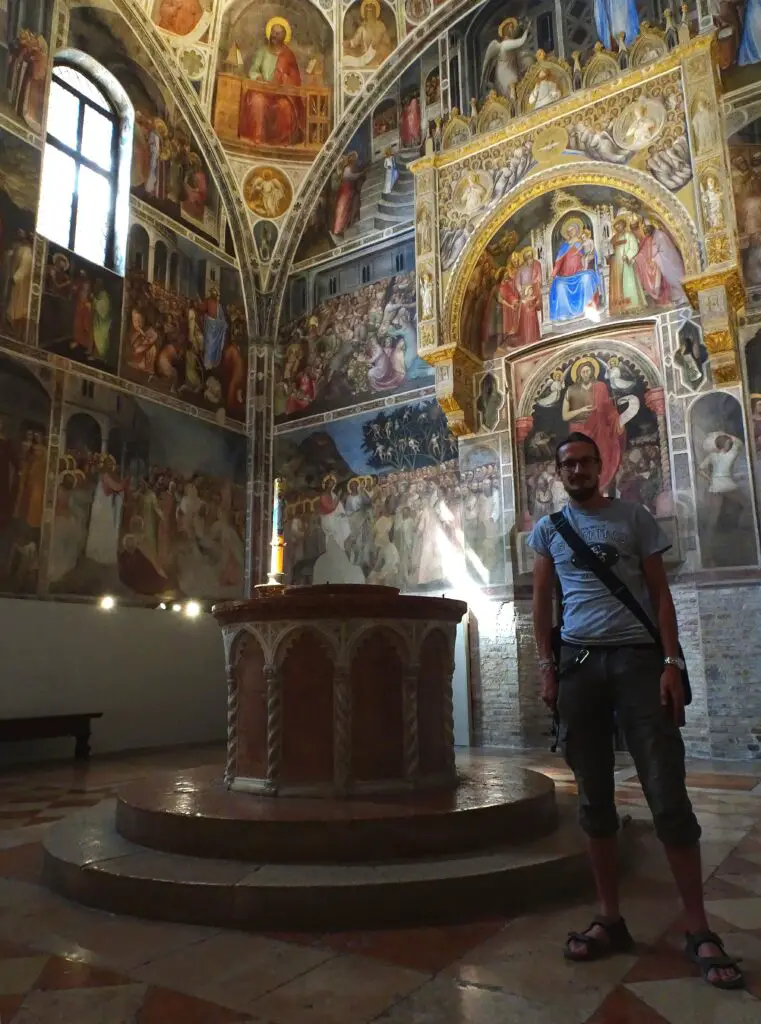
The latter contains a depiction of Jesus in the Pantocrator Style, surrounded by countless angels and saints. The walls feature scenes from the lives of Jesus, Mary and John the Baptist, while the small apse surrounding the altar is decorated with apocalyptical scenes from the Book of Revelations.
When visiting, you’ll have to decontaminate while watching a video about the history of the place before you’re allowed inside. Inside the Baptistery, you’ll get a useful audio guide explaining the meaning of the various scenes, so you don’t need to be an expert on Christian iconography to enjoy the place.
Palazzo de la Ragione
Padua’s former town hall and palace of justice dominates the city’s central market square and is decorated with frescoes painted by Nicolò Miretto and Stefano da Ferrara. As the only non-religious space in Padua containing fresco cycles, you’ll not only find depictions of saints but also of scientific figures of the time as well as scenes relating to Padua’s role as a trade centre.
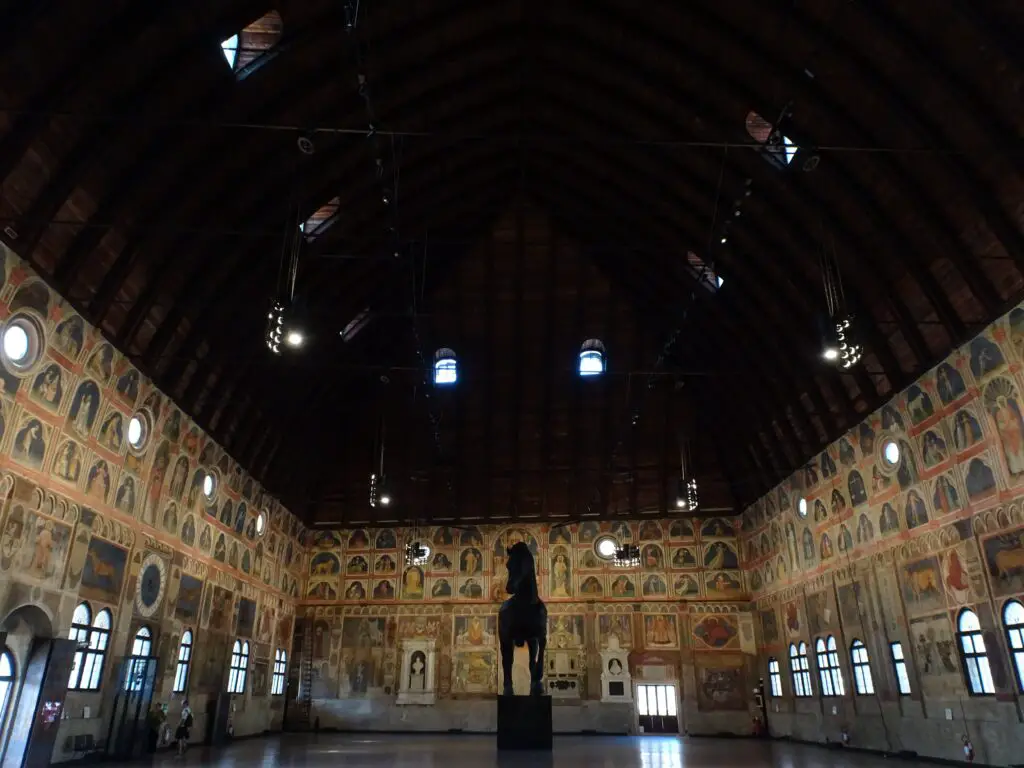
The big hall also contains a giant 15th century wooden horse statue, a Foucault Pendulum and the Pietra del Vituperio, a medieval stone pedestal, on which debtors hat to sit to be publicly shamed. A rather tame penalty considering the punishments that used to be dished out at the time. The arcaded loggia running around the hall has some nice views of the adjoining squares and more frescoes in the vaulted ceiling.
Chapel of the Carraresi Palace
The city palace of the influential Carraresi Family contains a room with frescoes by Guariento (yep, the one from the Eremitani Church). Once used as a private chapel, one of the walls in the room is painted with frescoes depicting scenes from the life of Noah, Abraham and other Old-Testament Stars.
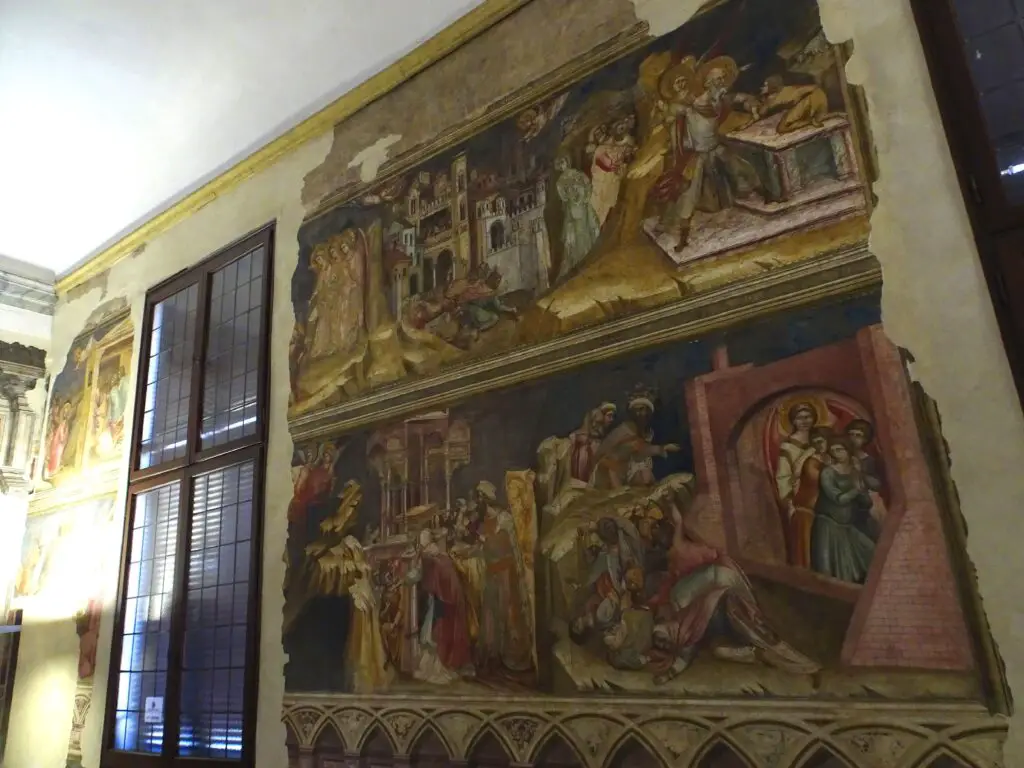
The frescoes can be visited half-hourly with one of the enthusiastic volunteers from the Accademia Galileiana di Scienze, Lettere ed Arti located in the palace.
Zone 3
Basilica of St. Anthony
This huge pilgrimage church is most famous for containing St. Anthony’s shrivelled up tongue and larynx, but there are also a few of the fresco cycles to be found. They’re a little hard to find among all the religious imagery in the big building, but I’ve got you covered.
The most impressive cycle is in the Cappella di San Giacomo, halfway down the nave on the right-hand side opposite of the sumptuous chapel containing the sarcophagus of St. Anthony. The frescoes painted by Altichiero da Zevio depict the live of St. James. There’s also a famous crucifixion scene.
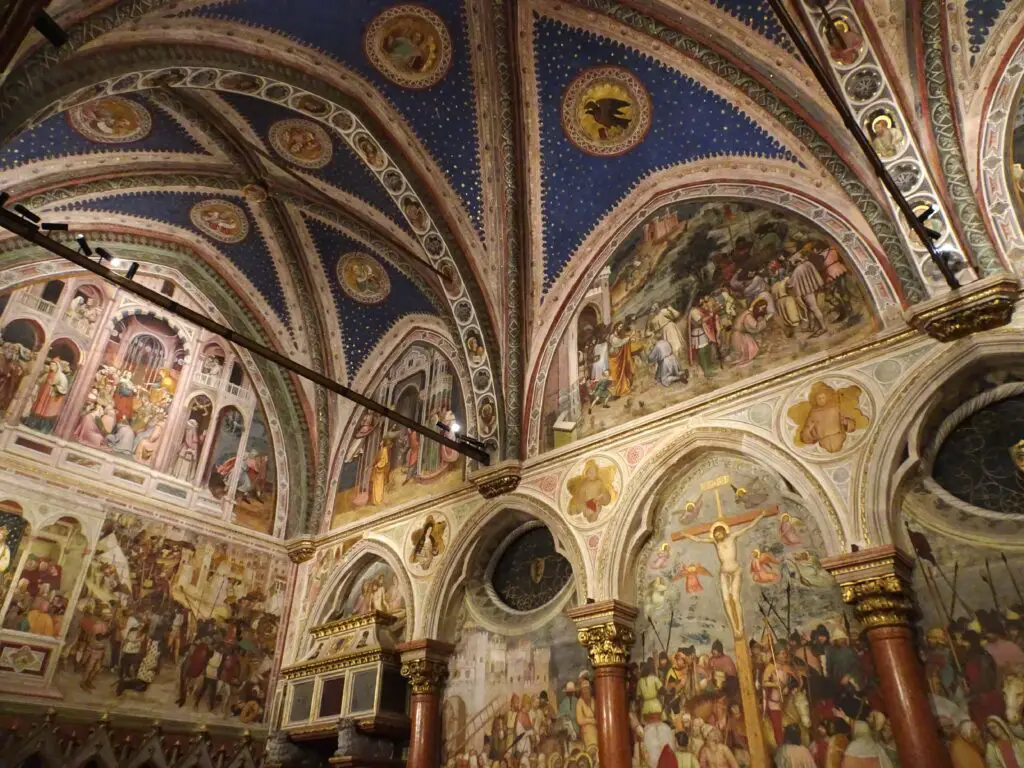
If you walk across the nave and face the Chapel with the tomb of St. Anthony, there’s a small side-room to the right of it containing the Chapel of the Dark Madonna (Cappella della Madonna Mora), named so for the darkish hair of the central statue of the Virgin Mary. The surrounding walls feature some small remnants of frescoes by Giotto. Also check out the beautiful side chapel to the left.
The Cappella del beato Luca Belludi is located behind the central altar area to the right of the chapel containing the relics of St. Anthony. The walls have been decorated by Giusto de’ Menabuoi (who also did the Cathedral Baptistery).
The Cappella delle Benedizioni used to belong to the Scrovegni family, who seems to have been quite insatiable when it comes to paintings by Giotto, who is also thought to have decorated this one. It’s the first subsidiary chapel on the right in the choir area, almost directly to the right of the main altar.
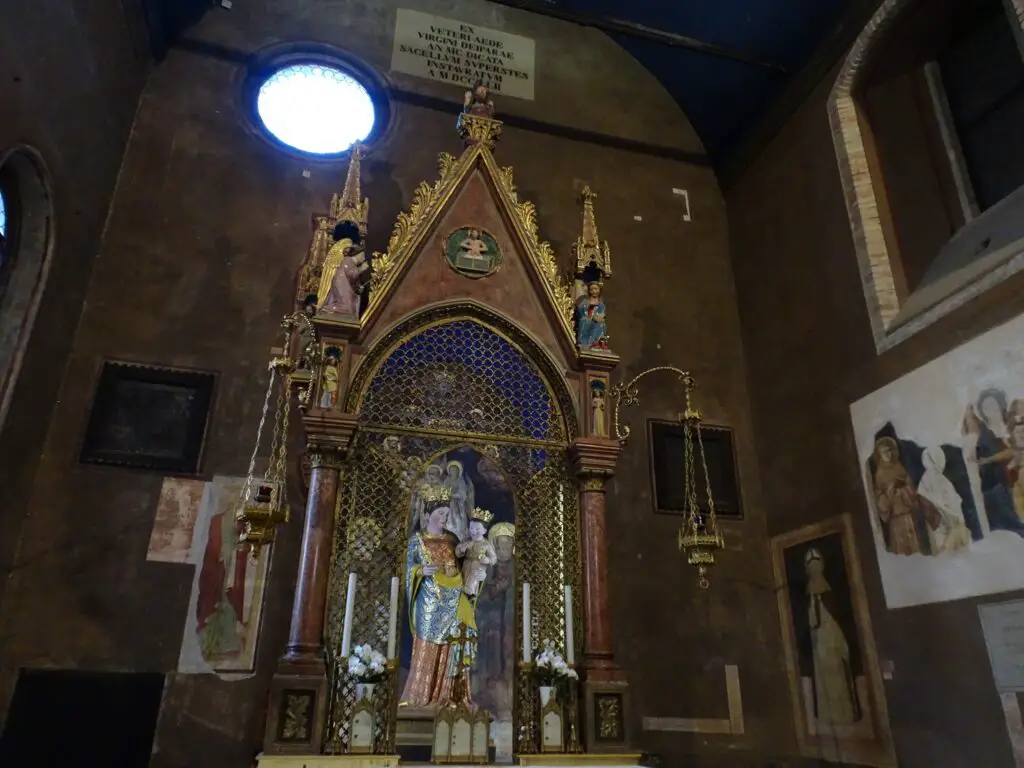
Serious completionists like myself will be annoyed to hear that at least one of the cycles can’t be visited by the general public. The chapter house also contains frescos by Giotto, but is part of the private monk’s quarters.
That leaves you only with the options to either become a monk, pretend to be one or sneak a peek through the occasionally open door (which was the case when we were there around 9.30 AM on a Friday – no idea, whether that’s indicative of anything).
Otherwise you can have at least a digital look at them here.
Oratory of St. George
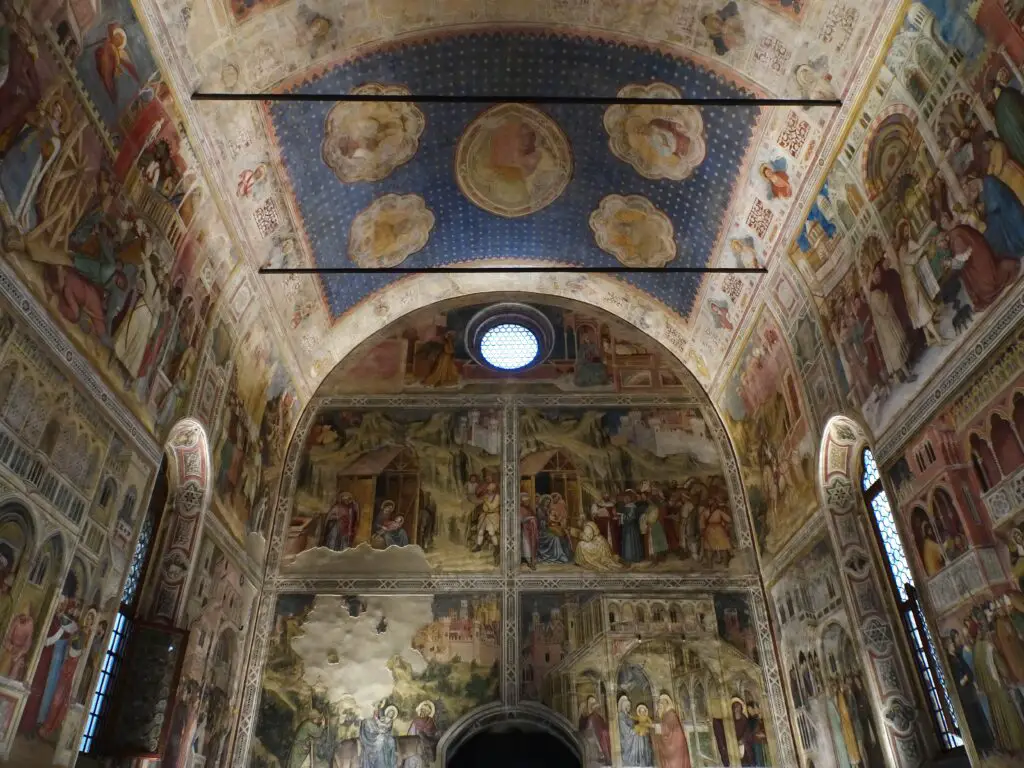
Right next door to the Basilica is the small Oratory of St. George, covered in frescoes depicting the lives of Saints George, Catherine and Lucy and of course scenes from the life of Jesus and Mary. Especially impressive is the crucifixion scene on the wall opposite the entrance. Also note the starry night sky painted on the pretty barrel vaulted ceiling.
Zone 4
Oratory of St. Michael
Sitting slightly isolated from the other sites on the southwestern edge of the city centre, the Oratory of St. Michael has a couple of frescoes by Jacopo da Verona. Some of them seem a bit unintentionally funny, including a disembodied hand dropping some liquid on the head of an annoyed looking angel.
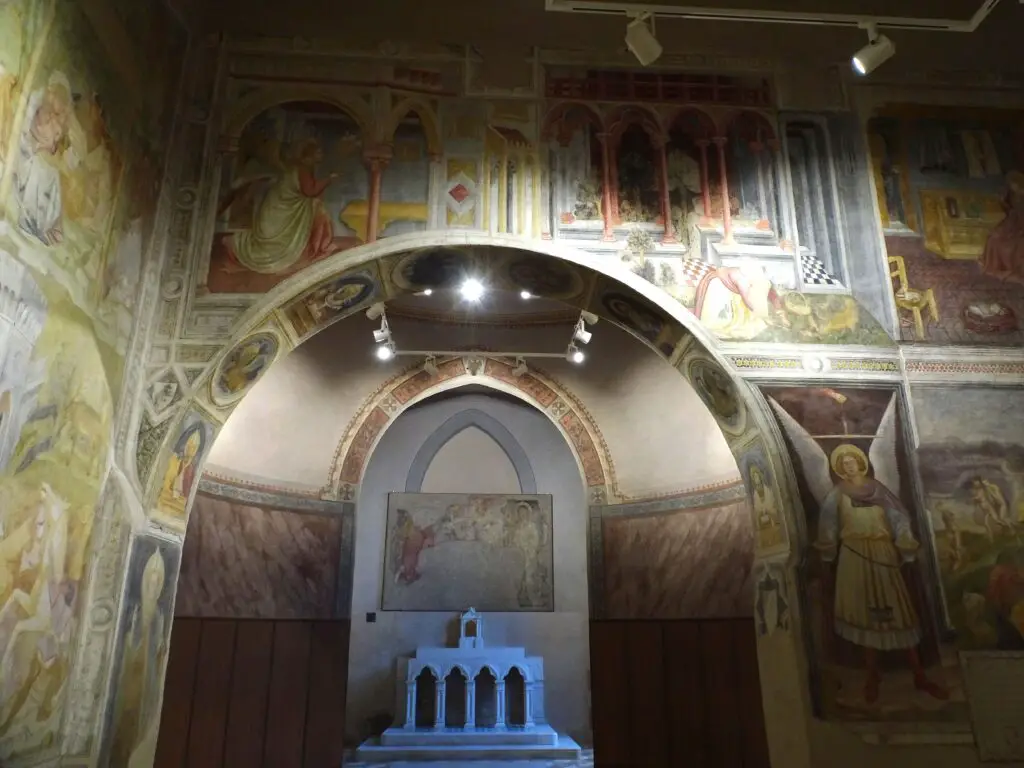
Also notice how Mary was so startled by the annunciation that she seemingly dropped right out of her chair. Stuff like that is why I love religious art. Visiting this site requires a bit of pre-planning as it’s only open for three hours per day. Check the opening times here.
Which is the best fresco cycle in Padua?
If you’re short on time or money or simply not a hardcore art fan, you probably want to know which of the frescoes not to miss. I’d say definitely check out the Scrovegni Chapel and the Cathedral Baptistery, which to me where the most impressive frescoes, while Stefanie’s favourite was the Palazzo della Raggione. Otherwise just have a look at the pictures above and find your own favourite.
Guided Tours of Padua’s Fresco Cycles
If you don’t have a lot of time and/or prefer the company of a knowledgeable guide, you could take a tour of Padova including the most important fresco cycles. This unique tour includes both the Scrovegni Chapel and the Baptistery of the Cathedral, arguably the most important sights among the fresco cycles.
Map of Padua’s 14th century Fresco Cycles
All of the sites inscribed in the World Heritage Property can be found on this map.
When to visit Padua’s fresco cycles?
The opening times of all the sites vary greatly. About half of the sites are closed on Monday but the main attractions (i.e. the Scrovegni Chapel, Cathedral Baptistery and Basilica of St. Anthony are open every day, albeit with differing times). You can check all of them on this website.
How much is the entrance fee for Padua’s fresco cycles?
All of the sites have different entrance fees, of which the Scrovegni Chapel is the most expensive at 14€. The Basilica of St. Anthony, Eremitani Church, and Chapel of the Carraresi Palace can be visited free of charge.
If you have the chance to visit a few more of the cycles, the Urbs Picta Card is a great deal. This allows a visit to all of the sites above as well as use of the public transport for either 48 hours (28€) or 72 hours (35€). Also included are Padua’s City Museum (Museo Civici) and the Museum of Applied Arts in the Palazzo Zuckermann.
You can get the card at the tourist information near the Café Pedrocchi or at the Museo Civici, where the Scrovegni Chapel is located. You can also get it online on this site.
Other Practicalities
How to get to Padua
Padua can easily be reached by train from Venice (about 30 minutes/5€), Verona (about 1 hour/8€) or Vicenza (about 30 minutes/5€). Padua’s Train station is located slightly north of the city centre across the Piovego Canal.
Where to stay in Padua
There’s no shortage of places to lay your head in Padua, although cheaper options tend to be somewhat sparser and a little out of the centre. We stayed at Albergo Junior, a few minutes north of the train station. It’s a cozy and very affordable bed and breakfast run by a friendly elderly couple.
The city centre is full of midrange options with great ratings, like Scrovegni Rooms and Breakfast or Residence Eremitani, which are right next to the Scrovegni Chapel.
The sumptuous Palazzo Mantua would be at the top end of the spectrum
Have a look at the map above for more options.
What else to do in Padua
Exploring Padua Botanical Garden, the Oldest Botanical Garden in the World
The Ultimate One Day Itinerary for Padua, Italy – The Veneto Region’s Medieval Gem
